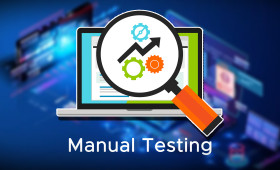Manual Testing
Manual testing is a software testing process where testers manually execute test cases without the use of automation tools or scripts. It involves carefully validating software applications to identify defects, ensure functionality, and assess overall quality. Manual testing plays a crucial role in the software development lifecycle, complementing automated testing and providing a human perspective on application behaviour. Manual testing is valuable for its flexibility, adaptability to complex scenarios, and ability to simulate real-world user interactions. While it may be time-consuming and dependent on human judgment, manual testing remains an essential component of the testing process, especially for exploratory and usability testing, until it can be supplemented by automated testing where appropriate.

Overview
Manual testing is a software testing process where testers manually execute test cases without the use of automation tools or scripts. It involves carefully validating software applications to identify defects, ensure functionality, and assess overall quality. Manual testing plays a crucial role in the software development lifecycle, complementing automated testing and providing a human perspective on application behaviour. Manual testing is valuable for its flexibility, adaptability to complex scenarios, and ability to simulate real-world user interactions. While it may be time-consuming and dependent on human judgment, manual testing remains an essential component of the testing process, especially for exploratory and usability testing, until it can be supplemented by automated testing where appropriate.
Course Description
Introduction
Ø What is Software Testing
Ø The Process of Software Development
Ø Project Vs Product
Ø Objectives of Testing {Why do we need to test?}
Ø Testing principles
Software Architecture
Ø Different layers (tiers)
System Environment
Ø Development
Ø QA
Ø UAT
Ø PRODUCTION
Software Development Life cycle
Ø SDLC
SDLC MODELS
Ø Sequential models
Ø Waterfall Model
Ø V-Model
Ø Incremental & iterative Models
Ø Agile methodology
Ø Introduction Agile process
Ø Agile manifesto
Ø Agile principles
Software Testing Methods
Ø White Box Testing
Ø Black Box Testing
Ø Grey Box Testing
Ø Agile Testing
Ø Ad Hoc Testing
Levels of Testing
Unit Testing
Ø Test approach
Ø TDD (Test Driven Development)
Integration Testing Test Approach
Ø Big Bang Integration
Ø Top-Down approach
Ø Bottom-up approach
Ø Stub and Driver
Ø Continuous Integration
System Testing Test Approach
Ø Requirement Based (Traceability)
Ø Risk-Based (Risk factor number)
Functional Testing & Non- Functional Testing
Ø Positive testing
Ø Negative Testing
Ø Compatibility Testing
Ø Performance Testing
Ø Load Testing
Ø Volume Testing
Ø Stress Testing
Ø Recovery Testing
Ø Parallel Testing
Ø Compliance Testing
Ø Mutation Testing
Ø Security Testing
Ø Usability testing
Regression Testing & Types
Ø Unit Regression
Ø Regional Regression
Ø Full Regression
User Acceptance Testing
Ø Alpha testing
Ø Beta Testing
Ø Regulatory Acceptance Testing
Ø Operational Acceptance Testing
Ø Contractual Acceptance Testing
Maintenance Testing
Ø Maintenance Test life cycle
Ø Change request
Ø Impact Analyss Document
Ø Type of Maintenance
Ø Corrective
Ø Perfective
Ø Adaptive
Software Testing Life Cycle ( STLC )
Ø Requirement Analysis
Ø Test Planning
Ø Test Scenario / Test Case Design
Ø Test Environment Setup
Ø Test Execution
Ø Test Closure
Test Process Documents
Ø Test Plan
Ø Test Scenarios
Ø Test case
Ø RTM ( Requirement Traceability Matrix)
Ø Defect Report
Test Case Authoring
Ø Functional Test case
Ø Review of Test Case
Ø Walkthroughs
Ø Inspection
Ø Peer review
Build Release Process
Ø Standalone Application
Ø Client-Server Application
Ø Web - Application
Defect Reporting & Tracking
Ø Defect Reporting
Ø Defect Life Cycle
Ø Severity & Priority
Ø Defect tracking tools
Test Closure
Ø Criteria for Test Closure
Ø Test summary Report
Agile Methoda And Approaches
Ø Introductionto Kanban & Best Practices
Ø Scrum
Ø Getting Agile with Scrum
Ø Scrum Origin
Ø Projects where Scrum can be implemente
Ø Characterstics of scrum
Ø Scrum framework
Ø Main roles of a scrum team
Ø Product Owner
Ø Scrum team
Ø Team
Ø Chickens
Planning in scrum
Ø Goals of Planning
Ø The Planning onion
Ø Define the Vision
Ø Create the Roadmap and Organize the Scrum Teams
Ø Release Planning
Ø Sprint palnning
Ø Daily Scrum
Ceremonies in Scrum
Ø Sprint Planning Meeting
Ø The Daily Scrum
Ø Sprint Review meeting
Ø Sprint Retrospection
Main artifacts of a scrum project
Ø Product backlog
Ø Sprint backlog
Ø Burn down charts
Ø Potentially Shippable Product increment
Ø Task board
Ø Using user stories to scale down a project
Ø Concept of user stories
Ø Format of user stories
Ø Writing user stories-examples
Ø Definition of done
Course Key Features
· Classroom and Online Training
· IT Experts as Trainers
· Industry Curriculum
· Real Intensive -Time use cases and Projects
· One to One with mentor
· Convenient Training schedules
· Per Day 8 Hours Lab support.
· Pre-Assessment Questions
· Course Material
· Swhizz Certification is valid for lifetime.
· Resume Building
· Interview Guidance
· Mock Interview
· Drives with Top companies
· Internship Opportunities
· Tie up with 50+ clients
Benefits
Who Should Attend
· Graduates
· Post Graduates
· Career Gap people
· Software Developers
· Operations Professionals
· Quality Assurance Engineers
· System Administrators
· IT professionals
· Associates
Course Outline for
Examination and Certification


